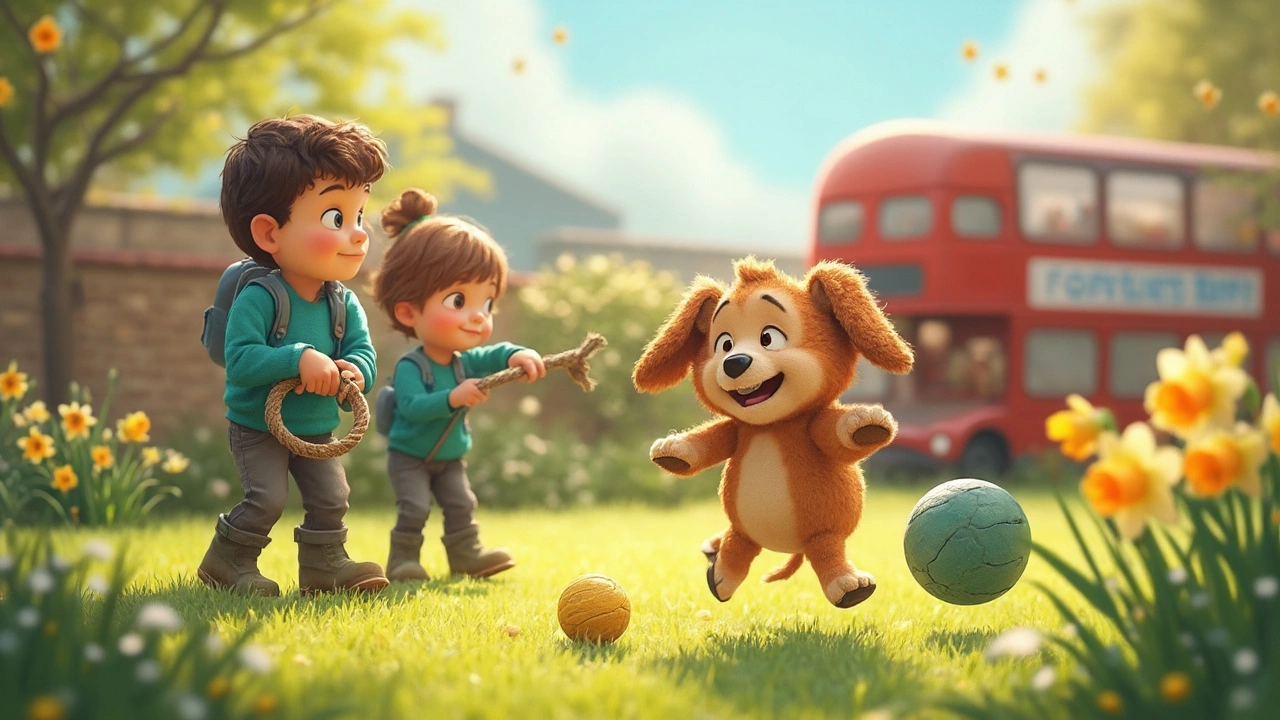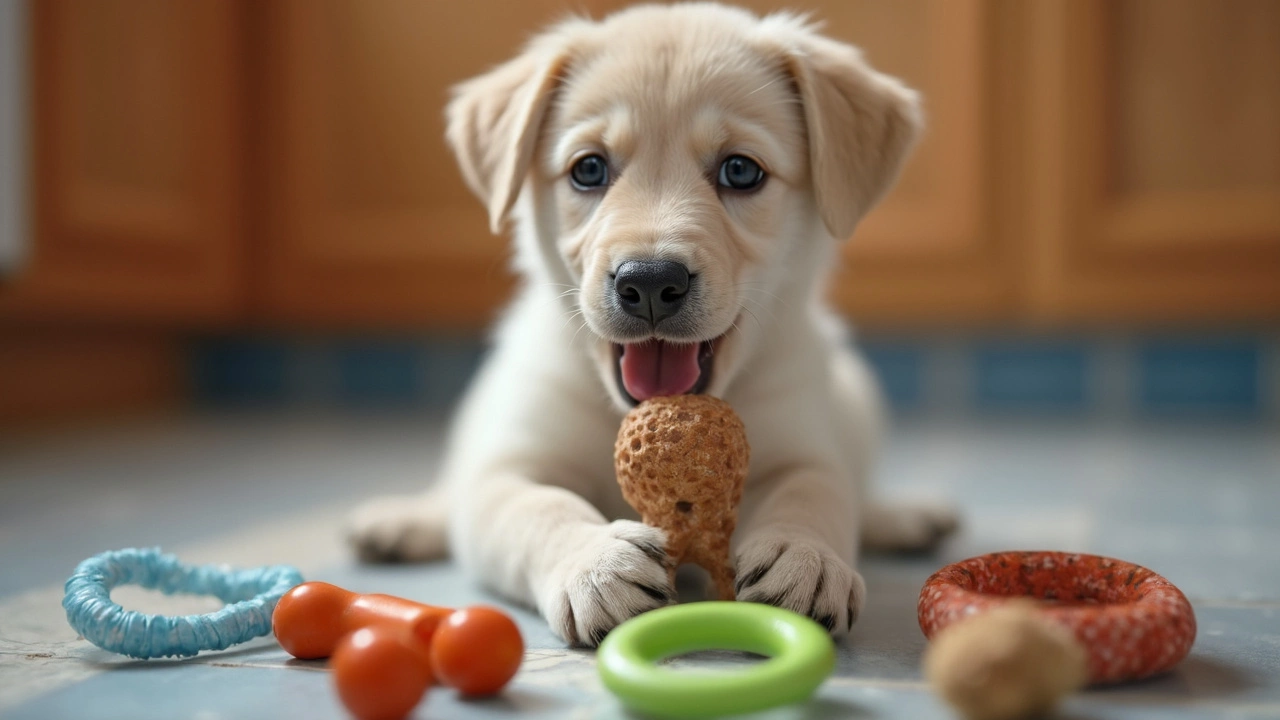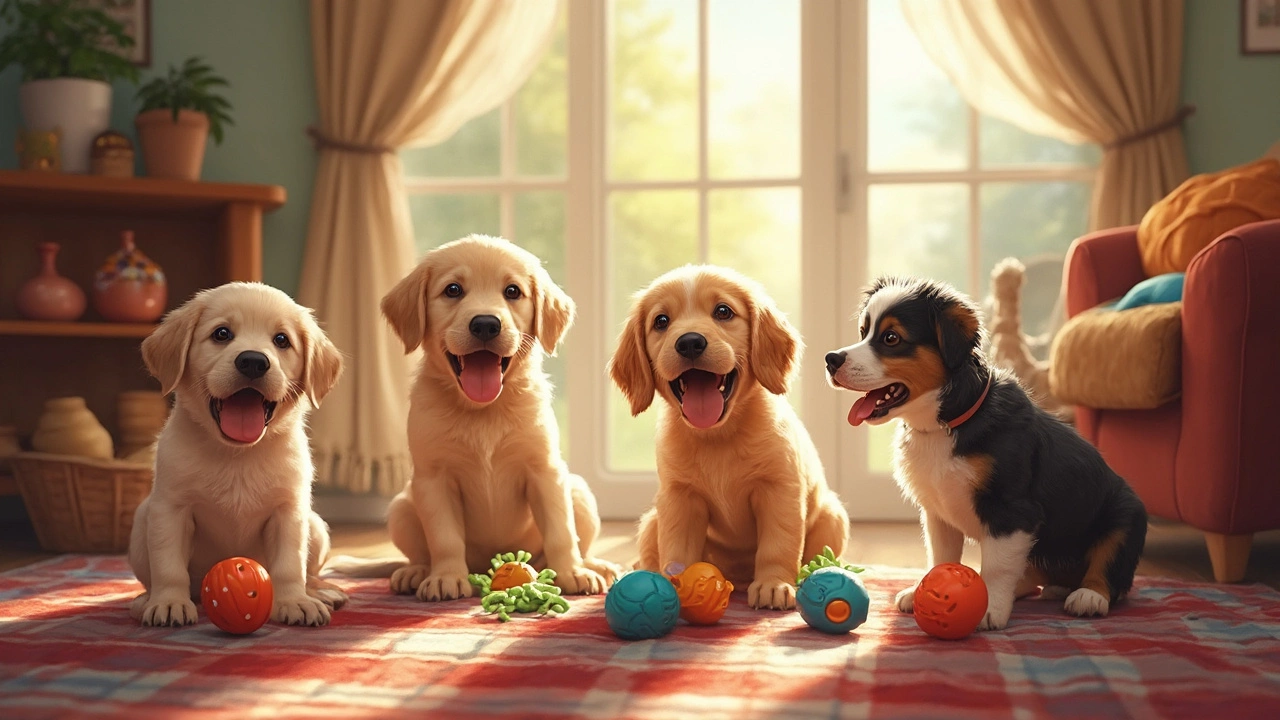Puppies go wild for toys—sometimes it feels like their whole world revolves around playtime. It's not just about burning off energy, either. Toys help them learn about their environment, build social skills, and keep out of trouble. If you've ever seen a puppy pounce on a squeaky toy or tug at a rope, it's clear that play is their language for figuring out the world.
But not all toys grab their attention in the same way. Some pups like soft plushies to cuddle and shake, while others are all about rubber chew toys. And if you think 'expensive means better,' you'll be surprised—sometimes a crumpled water bottle or an old sock can become their top pick. The trick is to learn what tickles your puppy's fancy and keeps them safe at the same time.
- Why Puppies Love to Play
- Toy Types Puppies Go Crazy For
- Safety First: Picking the Right Toy
- Teething, Training, and Toys
- Keeping Playtime Fresh: Rotation and DIY Ideas
Why Puppies Love to Play
Play isn’t just for fun—puppies rely on playtime to develop important life skills. Their brain and body are still growing, so they use games and toys to make sense of everything around them. Even the simple act of chasing a ball or wrestling with a plush monkey helps a puppy learn how to socialize, test boundaries, and get comfortable around people and other dogs.
There’s also some real science behind why puppies are obsessed with toys. When they play, their brains release feel-good chemicals like dopamine, which lowers stress and helps them feel happy and safe. A bored puppy is usually a troublemaker. Without enough mental and physical stimulation, a puppy might start chewing on furniture or barking at shadows just to keep themselves busy.
If you look at any puppy toys aisle, you’ll spot lots of varieties designed to meet these needs—from chewy toys for teething, to balls for chasing, to interactive toys that make them think. Each type of toy helps pups practice different things they’ll need as adult dogs, like patience, problem-solving, and sharing.
There’s also a bonding bonus: when you play tug or fetch with your puppy, they learn to trust you and read your cues. This is huge for training and makes life easier down the road. Plus, it’s just more fun for both of you.
Toy Types Puppies Go Crazy For
Walk down any pet store aisle and you'll see piles of toys, but not every toy gets a tail wag. Puppies divide their love between a few favorites, and it actually depends on their age and personality. So what toys always hit the mark?
- Rubber Chew Toys: These are a lifesaver for puppies teething nonstop. Brands like KONG or Nylabone nail it with tough, bouncy rubber toys that you can even stuff with treats. The chewing eases gum pain and keeps those little shark teeth away from your shoes.
- Plush Toys with Squeakers: Many pups can't resist a floppy stuffed animal that squeaks. It's the noise and the softness—plus they often drag them around like a mini security blanket. Just make sure they don't rip it apart and swallow the squeaker.
- Rope Toys: Great for tug-of-war, which burns energy and strengthens your bond. It also helps with teething. The knotted ropes clean teeth a bit, too.
- Interactive Puzzle Toys: Puppies love a challenge. Toys that make them work for treats boost their brains and curb boredom. Look for simple puzzles in the beginning and ramp up the difficulty as your puppy gets more confident.
- Fetch Balls and Discs: Some puppies (retrievers especially) have fetch instincts in their DNA. Balls or soft flying discs tire them out and help practice basic commands like "drop it."
Not sure what to try first? Here’s a quick look at what puppies usually go for at each stage, based on what actual puppy owners say works best:
| Puppy Age | Top Toy Types | Why Puppies Like Them |
|---|---|---|
| 8-12 weeks | Soft plush, mini rubber chews | Comfort, gentle on tiny teeth |
| 3-6 months | Rubber chews, rope toys | Teething relief, interactive tugging |
| 6+ months | Interactive puzzles, fetch balls | Mental challenge, energy burn |
Pay attention to size and durability. A chew that's too hard can break teeth, and a squeaky toy that's too small is a choking hazard. The main thing is to watch how your puppy plays and swap toys around to keep it interesting.
If you’re shopping, stick with puppy toys that match your dog's size and chewing style. Sometimes, the best toys are the simplest ones—one study reported that puppies often picked up a rope or a tennis ball over flashy electronic toys every time. So, when in doubt, keep it classic!

Safety First: Picking the Right Toy
It’s easy to get caught up in the cutest puppy toys at the pet store, but safety absolutely comes first. Puppies are like toddlers—curious, a little reckless, and always ready to stick just about anything in their mouths. Some toys can break or fall apart fast, and that’s how choking or stomach troubles happen.
The American Veterinary Medical Association says the biggest puppy toy risks are pieces that can be chewed off and swallowed. Always check the label. Look for toys marked as “puppy safe” or “for teething.” Skip anything with sharp edges, strings, buttons, or beads that could come loose. If you wouldn’t let a toddler have it, don’t give it to your puppy!
- Go for toys bigger than your puppy’s mouth to avoid choking.
- Rubber toys should be sturdy and not too hard—they need to flex, but not break apart.
- Plush toys should have strong stitching, and it’s best if they don’t have stuffing, as stuffing can quickly turn into a mess.
- Steer clear of old kids’ toys—they aren’t built for puppy teeth and might splinter or snap.
Bored pups love to destroy, so check toys regularly. It’s easy to miss a torn seam or a loose piece, but those are the most likely to end up swallowed. Toss damaged toys before they cause trouble.
| Type | What to Watch | Safe? |
|---|---|---|
| Rubber Chew Toys | Too hard, can break teeth | Usually safe if "puppy" labeled |
| Plush Toys | Buttons, loose stitching, stuffing | Safe if no loose parts |
| Rope Toys | Fraying, loose strings | Supervise play |
| Rawhide Chews | Can cause blockages | Not recommended |
| Hard Bones | May splinter or crack teeth | Best avoided |
Don’t forget, even the best puppy toys need supervision—no toy is totally indestructible. If your puppy is a super-power chewer, find out what works for their size and breed. And if you’re ever unsure, a quick call to your vet can save you a headache (and maybe an emergency bill!).
Teething, Training, and Toys
Puppies don’t just chew for fun—around three to six months old, they teethe hard. Their baby teeth fall out and adult teeth push through, which can get uncomfortable fast. If your puppy is gnawing on furniture (or your favorite shoes), it’s probably teething time.
The best toys for teething are tough but gentle on gums. Check for ones made from soft rubber or nylon. Frozen toys can work wonders too, especially during peak teething pain. You can even get toys you fill with a little wet food and freeze. This not only soothes sore mouths but keeps pups busy for ages.
Training goes hand-in-hand with toys. Instead of telling a puppy "no" every time it bites something wrong, steer it towards a chew toy as an alternative. This sets patterns early and makes bite training way easier. Some toys are made for tug, others dispense treats, turning play into mini-training sessions without your puppy even noticing.
Check out some simple tips to get the most out of puppy toys for puppies during this stage:
- Rotate a few chew toys around so your puppy always has a "new" one to try.
- Try treat-dispensing toys during crate training or when leaving your puppy alone, so it’s focused on the toy—not your absence.
- Pair short training commands, like "drop it" or "leave it," with play to teach rules in a fun setting.
Here’s a quick table to compare common toy types for teething and training:
| Toy Type | Best For | Safety Tip |
|---|---|---|
| Rubber Chews | Teething puppies, solo play | Choose the right size so they can’t swallow it |
| Rope Toys | Tug games, training commands | Supervise so they don’t eat threads |
| Treat Dispensing Toys | Crate training, mental stimulation | No small parts; wash often |
| Plush Toys | Comfort, light play | Replace if they rip |
The main thing? Stick with toys designed for puppies—not just any dog toy. It’s safer, eliminates the frustration of chewed belongings, and keeps your furry sidekick happy through all their stages of growing up.

Keeping Playtime Fresh: Rotation and DIY Ideas
Puppies get bored with the same old thing, just like people. If you notice your pup ignoring toys that used to be favorites, it might be time to shake things up. One approach that actually works: toy rotation. Simply put, you keep some toys out of sight and bring them back a few days later—the same toy will suddenly be fascinating again.
Vets and trainers often recommend keeping just three to five toys out at once, then swapping them every week. This keeps puppies engaged and mentally sharp. Here’s a simple way to do it:
- Pick out 3-5 toys for the week and store the rest in a box or closet.
- Every 5-7 days, swap in a few "new" ones from the stash.
- Keep one or two toys constant for comfort, like a special plushie.
Not only does toy rotation save your wallet, it also helps keep your puppy from chewing on things they shouldn’t. Studies from behaviorists (like a well-known one by Dr. Sophia Yin in 2017) show puppies with regular toy changes are less likely to mouth on furniture or shoes.
If you don’t want to buy more toys, DIY options can be just as much fun for your puppy. For example, try stuffing an empty water bottle in a sock (tie the end for safety)—most dogs go nuts for the crunchy sound. Or, make a simple tug toy by braiding strips of old jeans. Want to keep your puppy entertained longer? Hide treats in a muffin tin, then cover each hole with tennis balls and watch your pup figure it out.
Check out this quick table for some easy DIY ideas and how long they tend to last:
| DIY Toy | Materials Needed | Estimated Playtime |
|---|---|---|
| Sock Water Bottle | Old sock, empty plastic bottle | 1-3 days |
| Denim Tug Rope | Strips of old jeans | 1 week |
| Treat Muffin Tin | Muffin tin, tennis balls, small treats | 30 mins per session |
| Frozen Carrot Chew | Raw carrot, freezer | 20-40 mins |
Remember, the best puppy toys aren’t always the priciest ones. Mixing store-bought with homemade, and keeping playtime fresh, helps your puppy stay curious, happy, and out of mischief.

